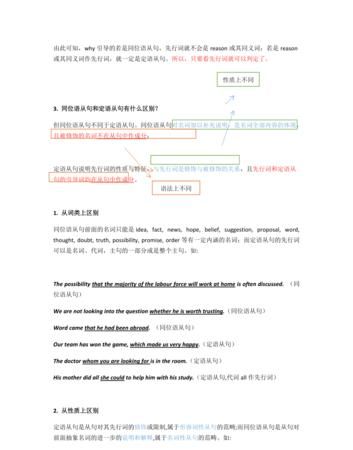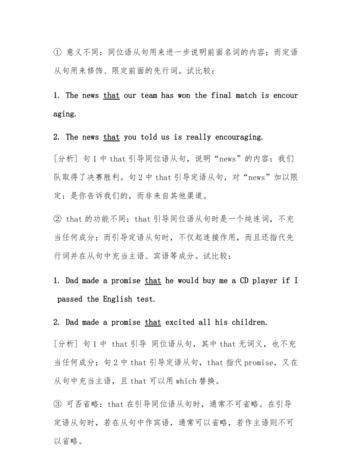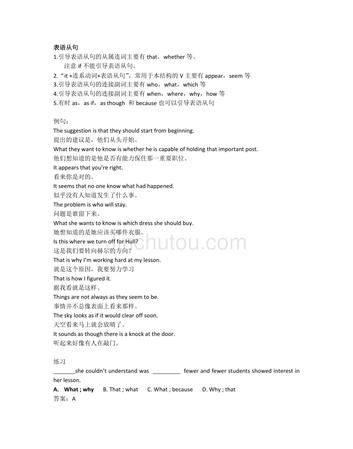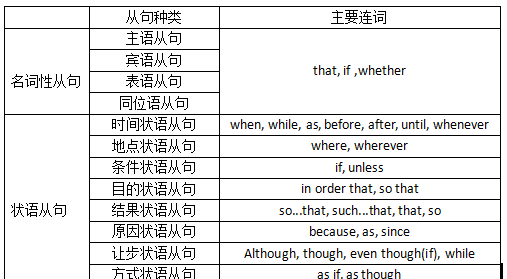本文目录
什么是同位语从句
同位语从句:that
有些名词的后面可以接that引导的同位语从句:
We came to the decision that we must act at once.
我们做出决定:我们必须立即行动。
He made a proposal that the meeting be postpone.
他提议会议延期。
There was little hope that he would survive.
他幸存的希望很小。
<><><>
that可以省略吗?
在非正式语体中that可以省略。
<><><>
以下名词常用于以上句型:
advice,announcement,argument,belief,claim,conclusion,decision,evidence,explanation,fact,feeling,hope,idea,impression,information,knowledge,message,news,opinion,order,probability,promise,proposal,remark,reply,report,saying,statement,suggestion, thought, treat, warning, wish, word
同位语从句:whether
whether可以引导同位语从句,而定语从句不能用whether作为引导词。
He hasn’t made the decision whether he will go there.
他还没有做出决定是否去那里。
I have small doubt whether he is suitable for the job.
他是否适合这件工作我有点怀疑。
同位语从句:what
what可以引导同位语从句,而定语从句不能用what作为引导词
I have no idea what he is doing now.
我不知道他现在在干什么。
同位语从句:how
how可以引导同位语从句,而定语从句不能用how作为引导词
It’s a question how he did it.
那是一个他如何做了此事的问题。
同位语从句:who等
who, whom, which, when, where, why用来引导同位语从句
The question who should do the work requires consideration.
谁该干这项工作,这个问题需要考虑。
She raised the question where we could get the fund.
她提出这个问题:我们到哪儿去搞这笔资金。
同位语从句和定语从句的区别(1)
同位语从句和先行词是同等的关系;而定语从句是用来修饰先行词,是从属的关系。
同位语从句和定语从句的区别(2)
that在同位语从句中没有词义,不充当句子成分;而在定语从句中充当主语、宾语等句子成分。
同位语从句和定语从句的区别(3)
whether, what, how可以用来引导同位语从句;而它们不能用来引导定语从句。
同位语从句和定语从句的区别(4)
一 从词义角度看问题
who, whom, which, when, where, why用来引导同位语从句是保持原来疑问词的含义;它们用来引导定语从句时,不具有疑问词的含义。
<><><>
二 从搭配角度看问题
who, whom, which, when, where, why用来引导定语从句时对应性很强,如:
先行词是“人”,引导词用“who”等,而它们引导同位语从句是先行词通常是“question, idea, doubt等”。

同位语从句的作文满分句型
同位语部分是个句子,就是同位语从句,这种用法比较"固定"
一、在复合句中用作同位语的从句叫同位语从句。它一般跟在某些名词后面,用以说明该名词表示的具体内容。
I heard the news that our team had won.我听到了我们队获胜的消息。
二、可以跟同位语从句的名词通常有news,idea,fact,promise,question,doubt,thought,hope,message,suggestion,words(消息),possibility等(一般的“抽象”名词都可用)。
I’ve come from Mr wang with a message that he won’t be able to see you this afternoon. 我从王先生那里来,他让我告诉你他今天下午不能来看你了。
三、英语中引导同位语从句的词通常有连词that,whether,连接代词what,who。连接副词how,when,where等。(注:if,which 不能引导同位语从句。)
He must answer the question whether he agrees to it or not. 他必须回答他是否同意这样一个问题。
四、有时同位语从句可以不紧跟在说明的名词后面,而被别的词隔开。
The thought came to him that maybe the enemy had fled the city. 他突然想起可能敌人已经逃出城了。
具体用法看下面百度百科的连接吧,够详细。也好理解

高中英语同位语从句讲解
同位语从句和主语从句、宾语从句、表语从句共同称为名词性从句。
同位语从句在句中起同位语的作用。它一般跟在某些抽象名词(如fact, news, idea, promise等)的后面,用以说明或解释前面的名词。
1. 引导同位语从句的连词多用that。that在同位语从句中只起连接作用,不充当任何成分,但不可省略。如:
① The fact that the earth is becoming warmer and warmer is clear.
② The news that our team won the football game inspired all the fans.
③ They introduced the idea that children could learn to read as babies.
④ Tom made his teacher a promise that he would never be late again.
2. 少数情况下同位语从句也可用连词whether和连接代词who,what,which或连接副词when,where,why,how等引导。
① I have no idea whether it is safe to sail in this weather.
② Have you got any idea who will take over now that the president has resigned?
③ Here comes the question what we should do with so much e-waste.
④ I have no idea when the general manger will come back.
下面给你附上几道高难度的同位语从句练习,时间关系,不作详解,但愿对你有所帮助:
1. The fact has worried many scientists ______ the earth is becoming warmer and warmer these years. (2009江西)
A. what B. which C. that D. though
2. News came from the school office ______ Wang Lin had been admitted to Beijing University. (2009四川)
A. which B. what C. that D. where
3. Tomorrow is Tom’s birthday. Have you got any idea ______ the party is to be held? (2008陕西)
A. what B. which C. that D. where
4. A warm thought suddenly struck me ______ I might buy a tie for my father’s birthday.
A. if B. when C. that D. which
5. Do you have any idea______ is actually going on outside the classroom?
A. that B. what C. as D. which
6. Along with the letter was her promise ______ she was free she would visit me this weekend.
A. that B. if C. what if D. that if
7. There remains a doubt among the public ______ the vaccine is safe enough for children.
A. whether B. that C. what D. how
8. The mother was filled with anxiety ______ her daughter might be disabled by the accident.
A. whether B. that C. what D. which
9. Standing in the hall, Patty had an uneasy feeling ______ somebody was watching her.
A. why B. whether C. that D. which
10. The doctor tried to remove the man’s fear______ his wife might die during the operation.
A. when B. that C. which D. what
【参考答案】1—5 CCDCB 6—10DAACB

同位语的具体用法和例句分析英语
同位语概念:一个名词(或其它形式)对另一个名词或代词进行解释或补充说明,这个名词(或其它形式)就是同位语。
例句:The report that he was going to resign was false.(他将辞职的报道是假的。)在此句中,that he was going to resign就是对report内容的说明,因此that引导的就是同位语从句。
The news that he won the match is so exciting.他赢得比赛的消息是如此的振奋人心。
这里that引导的从句做的就是同位语从句。因为that引导的从句就是the news的内容,是对the news 的进一步阐释,所以是同位语从句。
但是很多人很容易将同位语从句和定语从句搞混,请看下面的例句。
He is the man whom/ that I saw yesterday. 他就是我昨天见的那个人。
whom/that引导的从句在此句中引导的就是定语从句。从句和he的关系是从句对he进行限制,哪个he,昨天我见到的那个he.所以,只有汉语意思分析出来的话,就很好判断了。

扩展资料
用法
一个名词(或其它形式)对另一个名词或代词进行修饰,限定或说明,这个名词(或其它形式)就是同位语。
同位语与被它限定的词的格式要一致,并常常紧挨在一起。
同位语从句即重复说明同一个称谓或事件的从句。
名词作同位语
Mr Wang,my child’s teacher,will be visiting us on Tuesday.
王先生,我孩子的老师,星期二要来看我们。
(在这里'my child's teacher'做同位语修饰'Mr Wang')
短语作同位语
I,the oldest girl in the family,always had to care for the other children.
我,作为家里最大的女孩,总是要照料家中的其他孩子。
直接引语作同位语
But now the question comes to their minds,“Did she die young because she was a clone?”
但是现在他们不得不思考这样的问题:“多莉早死是因为它是一只克隆羊吗?”
句子作同位语
The girls were surprised at the fact that ocean ships can sail up the Great lakes.
巨大的海轮可以开到五大湖,让表姐妹俩感到吃惊。
固定用法
同位语部分是个句子,就是同位语从句,这种用法比较"固定"
一、在复合句中用作同位语的从句叫同位语从句。它一般跟在某些名词后面,用以说明该名词表示的具体内容。
I heard the news that our team had won.
我听到了我们队获胜的消息。
二、可以跟同位语从句的名词通常有news,idea,fact,promise,question,doubt,thought,hope,message,suggestion,words(消息),possibility,decision等(一般的“抽象”名词都可用)。
I’ve come from Mr wang with a message that he won’t be able to see you this afternoon.
我从王先生那里来,他让我告诉你他今天下午不能来看你了。
三、英语中引导同位语从句的词通常有连词that,whether,连接代词what,who。连接副词how,when,where等。(注:if不能引导同位语从句。)
He must answer the question whether he agrees with it or not.
他必须回答他是否同意这样一个问题。
四、有时同位语从句可以不紧跟在说明的名词后面,而被别的词隔开。
The thought came to him that maybe the enemy had fled the city.
他突然想起敌人可能已经逃出城了。
参考资料:百度百科 同位语从句
以上就是关于同位语从句固定句型 ,There is no doubt that这种以there的固定句型是什么语法了和形式...的全部内容,以及同位语从句固定句型 的相关内容,希望能够帮到您。
